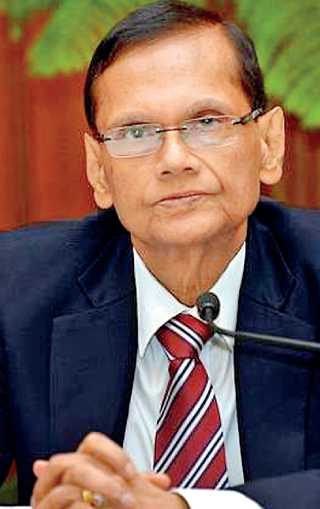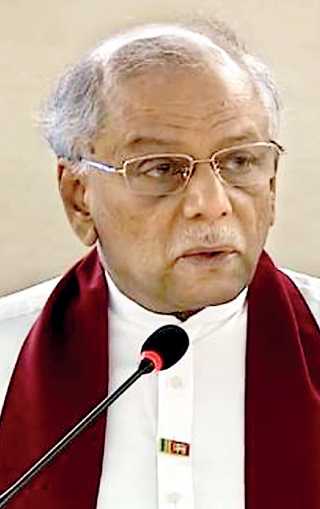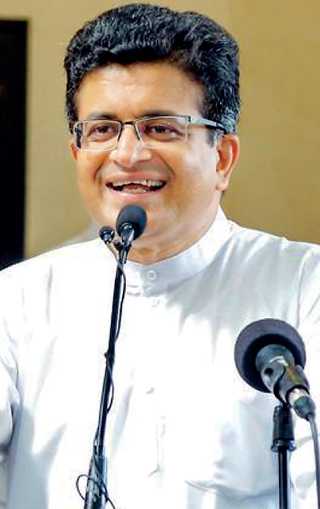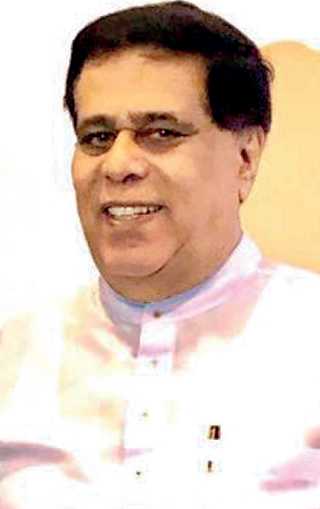Tuesday Dec 16, 2025
Tuesday Dec 16, 2025
Thursday, 27 August 2020 00:30 - - {{hitsCtrl.values.hits}}
The Presidential Policy Statement delivered at the inaugural of the new session of Parliament had three key takeaways. Firstly, the 19th Amendment is to be demolished, not rectified. Secondly, by means of the 20th Amendment, the electoral system will be replaced by one which is only secondarily that of proportional (or more correctly, proportionate) representation and primarily that of a first-past-the-post mechanism. Thirdly, there will be a totally new Constitution. 
A five-person committee has been named to draft the 20th Amendment. It comprises Ministers Ali Sabry, Prof. G.L. Pieris, Dinesh Gunawardena, Udaya Gammanpila, and Nimal Siripala de Silva. (Hopefully they’ll avoid the Felix Dias Bandaranaike path – and destination). There isn’t a single Tamil, and therefore no Tamil perspective, though the Tamil Question has been at the heart of constitutional reform efforts for four decades (since late-1983) and Douglas Devananda would have been an obvious choice.
Meanwhile the President added four senior members of the Buddhist clergy to the Task Force on Eastern Archaeological Heritage.
The strength of a state lies in avoiding the extremes of excessive loosening and tightening. The 19th Amendment and its precursor the 17th Amendment were the result of social shift against an excessively powerful presidency. More importantly they strove to rectify the partisan politicisation of the institutions, including the public service, identified by the post-1980s insurrection Youth Commission Report as a cause of revolt.
By eliminating rather than correcting the 19th amendment, the State is riskily re-installing two of the factors for revolt: an autocratic presidency and a re-politicised State apparatus.
 |
| President Gotabaya Rajapaksa |
 |
| Minister Ali Sabry |
 |
| Minister Prof. G.L. Pieris |
 |
| Minister Dinesh Gunawardena |
 |
| Minister Udaya Gammanpila |
 |
| Minister Nimal Siripala de Silva |
|
|
Electoral System
The 20th Amendment with its intention to eliminate alleged instability in Parliament and the stranglehold of extremism as referred to in the Presidential Policy Statement, sets up a straw-man and proceeds to bayonet it. No presidential system is rendered unstable by proportional representation in the legislature. The system of proportional representation does not inject diversity and pluralism into our society; it merely mirrors and accommodates it, containing it safely in the legislature.
If, however the system is a parliamentary democracy, then proportional representation can indeed generate a degree of instability. The directly-elected executive presidency guarantees stability even if the legislature, elected by proportional representation, is headed by another party—the French Fifth Republic, designed by General Charles de Gaulle precisely for stability, is the best example.
Nation-building cannot proceed by changing the electoral system so as to corral the minorities into one of the two major political formations, by re-introducing a high cut-off point.
The nostalgic glorification of the first-past-the-post system over proportional representation is nonsensical. The disastrously divisive and developmentally retrogressive Sinhala Only legislation, the abolition of the safeguards present in the Soulbury Constitution for the minorities and the retaliatory adoption of the destructive separatist platform of the Vadukkodai Resolution by the Tamil mainstream, all took place under the first-past-the-post system. Not a single piece of polarising legislation was passed under the system of proportional representation. What then is the logic of removing or reducing that system and restoring to a position of pre-eminence, the more damaging first-past-the-post system?
The problems of the preferential voting system can be fixed by cleaning up the election laws, including on campaign financing, and making the Election Commission still more independent.
If the goal is the reduction of the influence of minoritarianism, what then will limit majoritarianism? The proposed remedy may only achieve the miracle of driving the Tamil and Muslim parties together into a bloc of the Tamil-speaking people, creating a minority bloc, so as to vault the electoral barriers sought to be re-imposed. This will only enhance the island’s majority/minority polarisation.
The most dangerous outcome of the restoration of a high cut-off point, is the failure to understand the logic of its reduction from 12% to 5% by President Premadasa. The cut-off point was reduced to incentivise the JVP to re-enter the democratic mainstream and to remain in it. While the present JVP leadership is doubtless domesticated, it is quite unlikely that the JVP could do well in a preponderantly first-past-the-post-system with a minimal proportional representation component that has a high cut-off point.
In a country that has had two southern insurrections, it is both cynical and myopic to raise the barriers for left-inclined youth participation in electoral democracy. Not all alienated, literate young radicals in the rural areas may regard the Pohottuwa as the most resplendent vehicle for their social justice aspirations.
Ironically, parties such as Minister Devananda’s EPDP, which are represented in Parliament thanks to the present electoral system of proportional representation and President Premadasa’s reduction of the cut-off point, will be called upon to vote in favour of a new system which eliminates the very ground on which they stand.
New Constitution
Finally, the jewel in the crown—the new Constitution. There was a clearly articulated ‘Big Idea’ as the foundation stone of the two previous Constitutions. In 1972 it was a Republic and in 1978, the Presidency. There is no universally recognisable ‘big idea’ or concept that is being mentioned as the basis of the proposed new Constitution. The Chandrika ‘package’ and the UNP’s constitutional exercise had clear, recognisable concepts, however reprehensible and counter-productive: a ‘union of regions’, ‘the abolition of the executive presidency’, and ‘united not unitary’.
If there isn’t a master-concept, why and how can you have a new Constitution—instead of a slew of amendments—and if there is one, why is it kept hidden?
In his Parliamentary speech, Udaya Gammanpila mentioned a new “homegrown” Constitution. Is the new Constitution meant to unveil a ‘Sinhala-Buddhist State’? Is it a façade for a hegemonic, hierarchical System in which the Sinhala-Buddhist majority rules all other communities, the Rajapaksa clan rules the Sinhala-Buddhists, and the Presidency-Defence Mega (Ministry)-Monkhood ‘axis’ rules “über alles” i.e. above everyone and all else?
13A, India
In his Parliamentary debut, Gevindu Kumaratunga called for the abolition of the 19th and the 13th Amendments. The total abolition of the 13th Amendment is a diversion. In reality, 13A will be amputated with the surgical zeal of Procrustes.
The effort will be to shift back to the pre-1984/5 preference for the district as the unit of devolution, but this time while retaining the province—and the Provincial Council—as façade or camouflage. There will be two moves constituting one manoeuvre: the first will be the repossession (seizure) by the Centre, of some crucial subjects. The State Minister of Provincial Councils, Rear-Admiral Sarath Weerasekara was on TV news earmarking education and land as subjects for probable reallocation to the centre.
In 1970-1972, educational ‘reform’ by a Sinhala nationalist administration with a two-thirds majority gave rise to a militant Tamil youth and student movement. Earlier, with the settler-colonisation/population ratio issue, land was a motivator for federalism. Today’s agenda can be understood as the splicing by the GR regime of strands of Sinhala hegemonism, dating back to the 1970 SLFP government, as well as the post-1977 Mahaweli settler-colonial hawks and National Security Minister Lalith Athulathmudali (whose model was Israel).
The second move in the coming constitutional counter-reform offensive will be draining off most of the devolved powers of Provincial Councils to smaller units, under the guise of grass-roots development. India has an excellent Gram Rajya network of small-unit devolution (West Bengal being the original and best example) which has not siphoned-off power in the least from the much larger units of the linguistic states which are the main constituent unit of the Indian Union.
In a tweet, the Indian High Commission disclosed its reiteration to a TNA delegation that India’s stand remained “the full implementation of the 13th Amendment”. Colombo is likely to regard the statement as a rubber bone the Indian HC tossed the toothless TNA.
We seem to be on a time machine back to the days before the visit of Prime Minister Indira Gandhi’s special envoy G. Parthasarathy to Colombo.
India’s Foreign Minister, Dr. Jaishankar, is not only the son of India’s most outstanding strategic thinker, the late K Subrahmanyam, but was also the young assistant of the iconic G. Parthasarathy when he was engaged in shuttle diplomacy between Delhi and Colombo. Unilateral changes to what Delhi achieved through the efforts of the great “GP” (as he was known) and High Commissioner JN “Mani” Dixit, resulting in a bilateral agreement, will concern Delhi.
I was privileged to encounter and converse as a young man with three Indian policy giants: P.N. Haksar, G. Parthasarathy, K. Subrahmanyam. There’s a new book out on Prime Minister Indira Gandhi’s Principal Secretary P.N. Haksar’s view on Sri Lanka, which I haven’t read yet, but I do recall my conversations at his residence when his eyesight had almost failed. He said that he had urged a strategy quite different from that which he helped develop in the case of Bangladesh. In the case of Sri Lanka, he urged on Indira Gandhi, a non-military strategy of escalating international diplomatic pressure, but things developed with a coercive component in the mix instead.
Even more relevant today was my conversation with G. Parthasarathy, who told me that President Jayewardene had urged him to meet the Sangha hierarchy and convince it—because that was the main obstacle to devolution. He had therefore visited Kandy and paid a call on the Buddhist hierarchy which had assembled to hear him out. He said that from their reception, their responses and even the facial expressions, he knew his legendary persuasive rationality wasn’t working and never would in that milieu. He retained over the years the deep pessimism that he felt at that moment—which would perhaps explain why Shri Haksar’s purely moral-diplomatic ‘soft power’ recommendation for Sri Lanka was abandoned.
Today, the Sangha hierarchy (albeit with different personalities) has a formal, structured policy influence at the highest level, unprecedented in the post-Independence history of this island.
Apart from Dr. Jaishankar, there is (as D.B.S. Jeyaraj has noted) another Sri Lanka hand in Modi’s Cabinet. That’s Hardeep Puri, who was on the ground in Colombo even earlier than Dr. Jaishankar. A superstar diplomat who, as India’s PRUN-New York, won India a seat on the Security Council with more votes than Japan, he is prominently visible as a young officer in the photograph of J.R. Jayewardene and Rajiv Gandhi signing the Indo-Lanka Accord. If a Richard Holbrooke-type special envoy is ever needed, he’s the man.
It would therefore be a mistake to assume that the Modi administration being BJP and the Accord being the product of a Congress government, there would no continuity, institutional memory and seamless policy commitment on the matter in Delhi.
Will the Sri Lankan State’s military victory over the LTTE (2009)—with India’s assistance—enable it, under the hawkish GR regime, to renege on the promise made to achieve that crucial assistance, and instead roll back what was achieved not by the LTTE, but despite it, by India (1987)? The LTTE never accepted the 13th Amendment and waged war against the North-East Provincial Council. What the LTTE could not do may be done by its bitter enemies, one of whom has been elected President. Rollback would counterproductively confirm separatist propaganda that the LTTE was the only counter-power the Tamils had.
 13A roll-back
13A roll-back
Rollback was on the cards since the end of the war. A week after the victory of May 2009, President Mahinda Rajapaksa was torn between the instinctive impulse to fulfil his commitment to India and the mounting opinion within the state apparatus and his family, that there was no need now to do so. Indeed, the very mention of the promise to implement the 13th Amendment was seen as ideologically inimical and reacted against as such-- as I learned to my cost with my arbitrary dismissal six weeks after our singular Geneva UNHRC victory of late-May 2009. It was not coincidental that the first traceable manifestation of the GR succession project, the book ‘Gota’s War’ was authored in 2012 by a columnist who had already written in post-war 2009 that there was no reason any more to retain the 13th Amendment and the time had come to undo it.
More tellingly, a member of the “troika”, Lalith Weeratunga, at the time the Secretary to the President, said in his speech at the launch of ‘Gota’s War,’ that India was lucky that it was J.R. Jayewardene and not Mahinda Rajapaksa who was Sri Lanka’s President at the time of the air-drop. From a conversation with President Mahinda Rajapaksa, I could tell that as a pragmatist he was not amused.
A close confidant of President GR over many years, Prof. Rohan Gunaratne advised me in Singapore in 2010 not to waste my time and antagonise highly-placed readers by advocating 13A, because the decision-makers had ruled out devolution.
J.N. Dixit noted in his landmark speech to the United Services of India that among the motivating factors of Indira Gandhi’s Sri Lanka policy was the strategic concern that if Delhi were to be perceived by the 80 million Tamils of Tamil Nadu—the site of the first secessionist stirrings in India— to be insensitive to the fate of their ethnic kin and close neighbour, Sri Lanka’s Tamils, it could cause a degree of disenchantment to re-enter Tamilian collective consciousness to the long-term detriment of the Indian Union.
India’s credibility may be at stake, not merely among the 120 million Tamils worldwide, but also in the region and the world. If a small state can unilaterally move on and even partially roll-back the political outcome of a bilateral accord with India, into which Delhi invested time, energy, “blood and treasure”, then it may constitute a setback to its prestige and status in the neighbourhood and among its international partners. Given the mythos of the BJP’s Hindutva ‘universe’, this may also have deeper discursive resonances and dissonances.
In an (English-language) interview on Derana, Rear-Admiral Colombage, the new Secretary/MFA, smilingly set out the President’s perspective that “given its location, Sri Lanka is not a small country…it is a Big Power”. This mindset reinforced by external patronage could create an outpost which potentially impinges on the regional balance.
Survival requires the Tamil-speaking parties to initiate a single-issue ‘bloc’ in defence of the 13th Amendment, uniting the Opposition, cutting across the Govt.-Opposition divide, and isolating the Alt-Right ultranationalists.
The 15th death anniversary of Lakshman Kadirgamar fell this month, August. The Hansard records his passionate speech opening the debate on the August 2000 draft Constitution (with the 1995-97 “union of regions” rightly deleted). Kadirgamar’s speech was a powerful plea to help him give an answer to the question posed wherever in the world he went: ‘What, where and when is the political solution you are offering the Tamils?’
Narcissistic nationalism and self-delusionary supremacism run counter to the objective interests of the Sinhalese, Tamils, Muslims and the island-nation as a whole. Courtesy Donald Trump and COVID-19, the mentality has not been subject to constraint and containment by external reality. That reality-check awaits the outcome of what TIME magazine calls on its cover ‘The New American Revolution’.